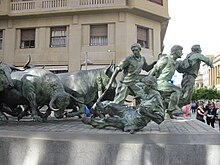
Back ষাঁড়ের সাথে দৌড়ানো Bengali/Bangla Stierlauf German Taŭrokuro Esperanto Encierro (tauromaquia) Spanish Entzierro Basque Härkäjuoksu Finnish Encierro French Táinrith na dtarbh Irish Encerro de touros Galician Utrka s bikovima Croatian
| Running of the bulls | |
|---|---|
 The bull run in Pamplona | |
| Dates | 7–14 July |
| Location(s) | Pamplona and other |


A running of the bulls (Spanish: encierro, from the verb encerrar, 'to corral, to enclose'; Occitan: abrivado, literally 'haste, momentum'; Catalan: bous al carrer 'bulls in the street', or correbous 'bull-runner') is an event that involves running in front of a small group of bulls, typically six[1] but sometimes ten or more, that have been let loose on sectioned-off streets in a town,[1] usually as part of a summertime festival. Particular breeds of cattle may be favored, such as the toro bravo in Spain,[1] also often used in post-run bullfighting, and Camargue cattle in Occitan France, which are not fought. Bulls (non-castrated male cattle) are typically used in such events.
The most famous bull-run is the encierro held in Pamplona during the nine-day festival of Sanfermines in honor of Saint Fermin.[2] It has become a major global tourism event, today very different from the traditional, local festival. More traditional summer bull-runs are held in other places such as towns and villages across Spain and Portugal, in some cities in Mexico,[3] and in the Occitan (Camargue) region of southern France. Bull-running was formerly also practiced in rural England, most famously at Stamford until 1837.
- ^ a b c Fiske-Harrison, Alexander (editor) The Bulls Of Pamplona, Mephisto Press, 2018
- ^ "Sanfermin guide: Running of the bulls". Kukuxumusu. 2007. Archived from the original on 5 May 2008. Retrieved 21 July 2008.
- ^ "Bull-run hits liquor-fueled town", 2 February 2009. "The tradition, enacted in a handful of Mexican towns, traces its roots back to the centuries-old Pamplona bull-run in Mexico's former colonial power." Retrieved 4 March 2009.